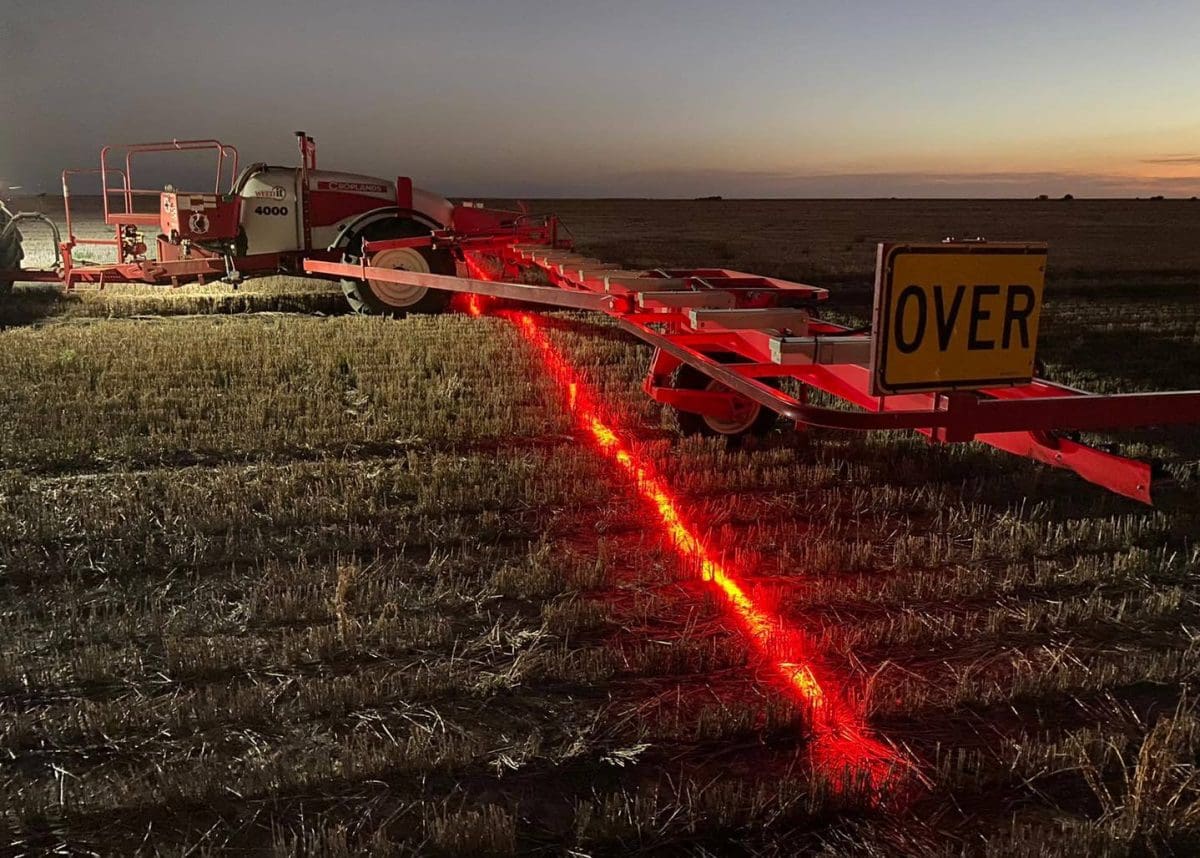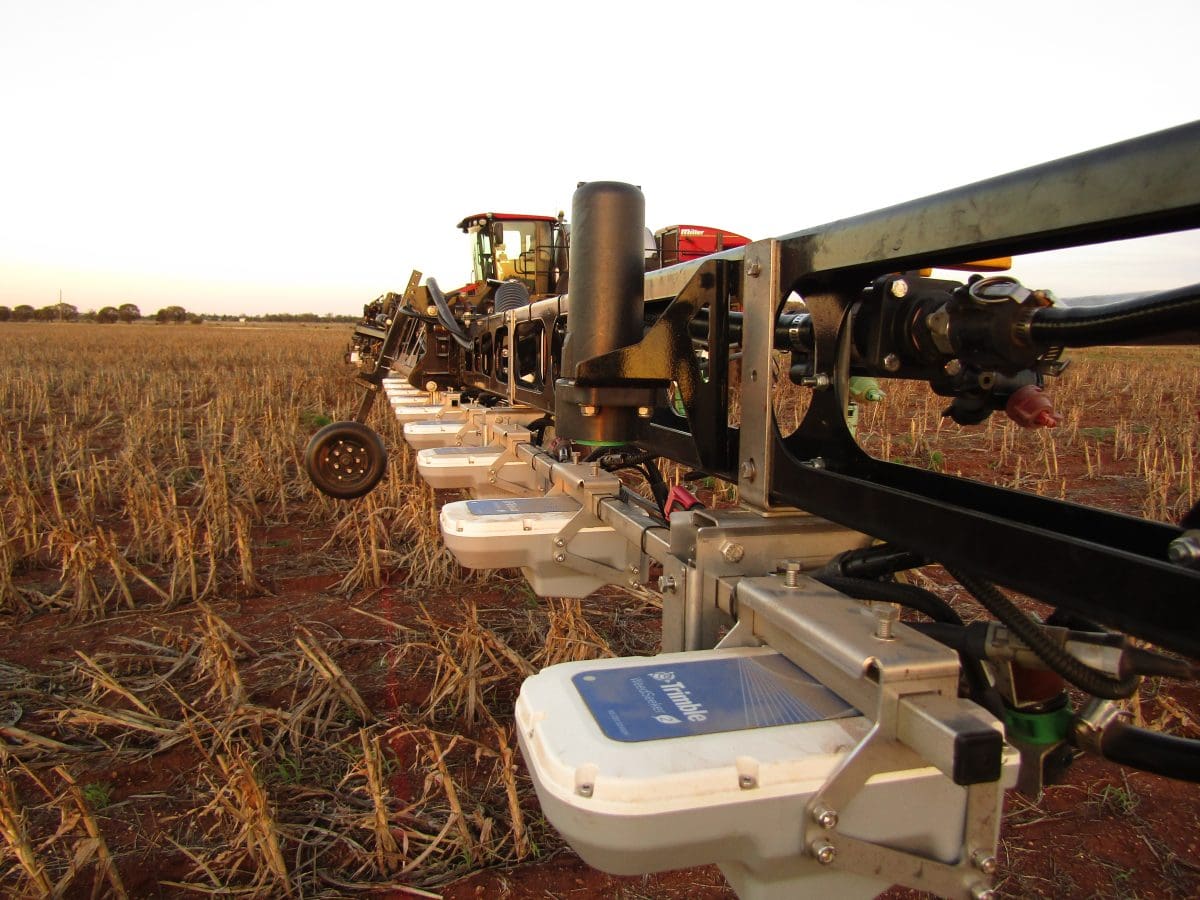
WEED-IT in use at Beefwood Farms north of Moree, NSW. Photo: Kurstjens Farming Australia
FEATHERTOP Rhodes (FTR) grass is on the march, and not far behind it is an expanding area of adoption for optical spot-spraying.
It is being driven not just by summer weeds like FTR, but also the availability of green-on-green spraying.
Favouring summer germination, FTR initially infested roadsides and fencelines, and it is now among Australia’s top eight grain-crop weeds in terms of its impact on yield and revenue.
It is notorious for being hard to kill with standard rates of glyphosate.
Rometron Australia managing director Brendan Williams said FTR’s spread and tenacity have boosted demand for WEED-IT technology in the past two years.
“Feathertop Rhodes grass has spread from Central Queensland all the way to Victoria now,” Mr Williams said.
“It’s a particularly invasive sort of weed and very difficult to kill with normal application rates.”
Mr Williams said the spread of FTR has seen WEED-IT’s customer base spread south from the initial cluster in the northern region, and north from the second one centred on the sandy soils of the south.
“We’ve had a band of adoption in the South Australian and Victorian Mallee and a band of adoption around Goondiwindi, Moree and Dalby, and now the two are joining up, pretty much because of FTR.”
Mr Williams said the spread of FTR, the incidence of summer weeds generally in areas of winter-dominant rainfall, and high herbicide prices have combined to spark a new round of interest in green-on-brown sprayers.
“With sandy soils in summer, you only need 5 millimetres of rain and you’ll get a germination, whereas with the heavier clays in the north, you’ll need 25mm, and 5-10mm falls on the lighter country in places like the Mallee are pretty common in summer these days.”
Like any optical spot-spraying technology, WEED-IT does not come cheap.
At around $5000 per metre, the ballpark outlay is $180,000 for a system to fit a 36m boom.
However, Mr Williams said the technology does well at covering its capital cost.
“Some people can do six weeks of spraying and save $150,000 in chemical.”
Adapted from Dutch technology
Mr Williams’ career is a varied one, and includes agricultural engineering and directorships of farming and related companies, with broadacre spraying a focus.
Through his own company, GPS-Ag, WEED-IT technology was adapted to fit Australia’s broadacre requirements, and the first unit was sold in the Goondiwindi district in 2009.
Mr Williams found out about WEED-IT in 2008, when a Dutch backpacker working at GPS-Ag mentioned the concept.
“We were pretty much having beers on a Friday afternoon, and he mentioned there was this thing in The Netherlands… for pavement spraying that was 2m wide.”
The technology relies on the chlorophyll in weeds reacting to a bright light source.
The result is fluorescence, and WEED-IT sensors detect the near-infrared (NIR) light radiated.
It’s the concept for green-on-brown spraying which allows weeds to be spot sprayed in fallow.
“It’s like the weeds are glowing in the NIR darkness, so this makes them easy to see in stubble.
“We’re very happy that some of our competition is chasing the green-on-green rainbow.”
While Roundup now costs around $9.50 per litre, Mr Williams said WEED-IT was initially made popular when the price hit $12 per litre.
“Through GPS-Ag, we were selling WEED-ITs for 10 years before they entered any other market outside The Netherlands.”
“For a fair few years, we didn’t do very much, and then we opened up a distribution agreement with Croplands.”
The Adelaide-based company remains a distributor of WEED-IT, and in 2020 Mr Williams set up Rometron Australia, part owned by the WEED-IT developer Rometron in The Netherlands, to act as a sister supplier to Croplands.
“In the past 12 months since we’ve been involved, we’ve pretty much doubled sales, and Croplands is still selling too in friendly competition.
“There’s twice as many sold since we’ve come on board.
“WEED-IT’s sales used to be 2500 sensors a year, and now it’s closer to 5000.”
“The only real limitation is finding sprayers to put them on.”
Foot in both camps
McIntosh Distribution has a dealership network across mainland Australia, and now sells Bilberry as well as WeedSeeker equipment.
While WeedSeeker uses infrared and red light sensors to spray green on brown, Bilberry uses RGB cameras to detect in-crop weeds for green-on-green spraying.
Bilberry’s first broadacre commercial use in Australia was in 2020 on the Messina family’s operation at Mullewa in Western Australia, and Bilberry’s office in Perth is its only one outside company headquarters in France.
McIntosh Distribution Weedseeker2 Tamworth-based product manager Scott Jameson said increasing accuracy as well as economic and agronomic factors had boosted grower interest in new and improved optical-spraying technology.
“The higher the glyphosate price goes, the more you see need for spot sprayers bubbling to the top of farmers’ shopping lists,” Mr Jameson said.
“On the east coast, demand is fairly high, and herbicide prices are a key driver.”
Mr Jameson said in the not-too-distant future, growers are likely to be asked not if they want a spot-spraying system, but what type they want at the point of order.
“I can see it where OEMs say: ‘Do you want spot-spray out of the boom…green on green, or green on brown?
“It will be a necessity to have.”

Trimble Agriculture’s WeedSeeker2 sensors are used to spray weeds growing in fallow. Photo: McIntosh Distribution
Green on green moving in
A number of growers are using green-on-green systems to spray weeds in crops.
They include Grenfell, NSW, farmer Broden Holland and father Chris Holland, who have been using a retrofitted Bilberry system since the middle of last year.
“Before that, we were spot-spraying in crop by turning sections of the boom on and off based on what we could see, and it was pretty hit and miss,” Mr Holland said.
Exciting times, spot spraying broadleafs out of cereals at 24km/h @BilberryAgri @GoldacresAust #greenongreen pic.twitter.com/goqYNKFdMb
— Broden holland (@brodenholland) May 10, 2022
However, the result was more economical than blanket spraying.
“Our weed numbers are so low that we find it really hard to justify $30/ha with big heavy products and blanket spraying.”
The Hollands crop around 3800ha of wheat and canola with a pasture phase in rotation, and have used the Bilberry for green-on-brown spraying over summer with pleasing results.
Now that seeding is finished, they will be using Bilberry’s broadleafs-in-cereals algorithm ahead of canopy closure on wild radish and volunteer canola in wheat.
“If you can see the weed with your eyes, the camera will see it.”
Mr Holland said some teething problems have to be expected.
“The asterisk on this is that it’s all very new.”
He said they were also planning to work with Bilberry on developing an algorithm for black oats in wheat.
“That’s the sort of thing you can do when you’re working with a smaller company.”
Grain Central: Get our free cropping news straight to your inbox – Click here

HAVE YOUR SAY